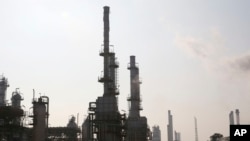Facing crippling economic sanctions, inflation and widespread social unrest, the Iranian government has boosted oil sales to China at a highly discounted price.
Iran does not publish statistics about its oil sales, but analysts say Tehran has increased oil exports to more than 1.2 million barrels per day over the past three months. Iranian oil reaches the Chinese market through a camouflaged system of delivery that the Iranian regime has perfected over the past several decades of Western sanctions.
“[The] Iranian regime is now very experienced in bypassing sanctions that it is also doing it for Venezuela or even Russia,” Mahdi Ghodsi, an economist at the Vienna Institute for International Economic Studies, told VOA.
Iran is among the five largest crude oil producers in the world and can produce more than 3.5 million barrels of oil per day, according to the U.S. Energy Information Administration.
Iran’s oil production reportedly hit a 30-year low in 2020 because of intensified U.S. sanctions as well as the economic impact of the global COVID-19 pandemic.
In the absence of official data, exactly how much Tehran makes from its oil and gas exports isn’t known. Estimates vary from $15 billion to $30 billion annually.
“Iran's oil revenues fell from $100 billion to $8 billion a year after the U.S. withdrew from the JCPOA [Joint Comprehensive Plan of Action, also known as the Iran nuclear deal],” said Umud Shokri, an analyst of global energy affairs.
The U.S. left the JCPOA in May 2018.
China benefits
Iran is the third largest provider of oil to China after Russia and Saudi Arabia.
The U.S. and its Western allies have also imposed sanctions on Russian oil and gas exports in an effort to force Moscow to end the war in Ukraine.
Since December, the G-7 — U.S., Canada, Germany, France, Italy, Japan, the U.K. and the 27-nation European Union — has imposed a $60 per barrel price cap on Russian crude oil.
While sanctions and the price cap have hurt oil revenue for both Russia and Iran, China appears to be benefiting.
The G-7 price cap on Russian oil is more than $25 lower than the Brent crude oil price. Iran sells to China at a price even lower than that.
“China benefits at least by 25% of Brent oil in terms of discount, which is enormous in the scale of 1.2 million barrels per day only for Iran's oil,” said Ghodsi.
“Iran offers steep discounts for its oil — likely even steeper than a year ago given new competition with Russian crude — to persuade Chinese refiners to accept the risk of dealing with sanctioned Iranian entities,” said Henry Rome, a specialist on Iran sanctions and economy with the Washington Institute for Near East Policy, speaking with VOA.
To camouflage transactions with a globally sanctioned Iran and also to make the most out of the oil purchase, China uses a barter trading system in which oil is exchanged for Chinese products including medicine, light machinery and food items.
“China is the biggest winner of the Iranian oil embargo,” said Shokri.
For Iran, however, the increase in oil sales is far from a stable solution for its longstanding economic woes.
The country has suffered chronic inflation that has pushed millions below the poverty line.
U.S. response
The United States is aware of and continues to monitor Iran’s oil sales to China, says U.S. Special Envoy for Iran Robert Malley.
“We have been in contact with Chinese authorities, and we will continue to sanction those who are involved in the import of Iranian oil,” Malley told Bloomberg News this week.
Some analysts say the U.S. focus on countering the Russian war in Ukraine has given Iran an opportunity to boost oil exports not only to China but also to India and Turkey.
Separately, Saudi Arabia, the world’s largest oil exporter, has continued to supply oil to China while also significantly increasing bilateral trade with Beijing.
In 2021, U.S.-Saudi trade volume reached $24.7 billion, a marked increase since it hit a record low during the pandemic. In the same year, the Arab kingdom’s trade volume with China hit $87.3 billion, 30% higher than in 2020.









